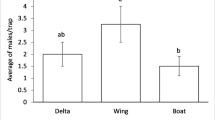Abstract
The larvae of the legume pod borer, Maruca vitrata (Lepidoptera: Pyralidae), cause severe damage on economically important legume crops in the tropics. The female moth produces volatile components to attract males for mating. The so-called sex pheromones are species-specific multi-component blends and are used as lures in crop protection for pest monitoring. Their chemical identification and ratios is critical to design efficient lures. The following sex pheromone components for M. vitrata have been described: (E, E)-10,12-hexadecadienal (major compound), (E, E)-10,12-hexadecadienol and (E)-10-hexadecenal (minor components). The ratio of 100:5:5 of these components was the most attractive in trapping experiments in Benin, Africa. According to this ratio, a synthetic pheromone lure was developed for commercial use. But the commercially available blend was not attractive in field trapping experiments in other regions of sub-Saharan Africa and Southeast Asia. These findings lead to the conclusion that there is a possible polymorphism in the blend composition of the M. vitrata sex pheromone among populations from different geographical regions. In Taiwan, M. vitrata moths were never caught efficiently by the commercially available pheromone lures and traps. This paper reports trap and lure optimization experiments for effective trapping of Taiwanese M. vitrata moths in different leguminous crops.
Zusammenfassung
Die Raupenstadien des Leguminosenbohrers Maruca vitrata (Lepidoptera: Pyralidae) verursachen in den Tropen schwere Fraßschäden an wirtschaftlich bedeutenden Gemüseleguminosen. Das Mottenweibchen produziert flüchtige Verbindungen und gibt diese ab um Männchen zur Paarung anzulocken. Diese sogenannten Sexpheromone sind artspezifisch und bestehen aus mehreren Komponenten. Im Pflanzenschutz werden synthetische Sexpheromone als Lockstoffe in Fallen eingesetzt, um den Schädlingsbefall zu kontrollieren. Ihre chemische Identifizierung und das Verhältnis der einzelnen Komponenten zueinander sind entscheidend, um effiziente Lockstoffe zu kreieren. Die folgenden Sexpheromonkomponenten sind für M. vitrata beschrieben: (E, E)-10,12-Hexadecadienal (Hauptkomponente), (E, E)-10,12-Hexadecadienol und (E)-10-Hexadecenal (Nebenkomponenten). In Feldversuchen in Benin, Afrika konnte mit einem Verhältnis dieser Komponenten von 100:5:5 die höchste Fangrate erzielt werden. Basierend auf diesen Ergebnissen ist ein kommerzieller Lockstoff erhältlich. Dieser ist aber in anderen Regionen Subsahara-Afrikas und in Südostasien nicht effizient für den Fang von M. vitrata-Faltern gewesen. Diese Tatsache weist auf die Existenz eines Polymorphismus innerhalb der Sexpheromon-Zusammensetzung von geographisch verschiedenen Populationen dieser Art hin. In Taiwan war der Einsatz kommerziell erhältlicher Lockstoffe für M. vitrata nie erfolgreich gewesen. Dieser Beitrag berichtet über Feldversuche in Taiwan, die sich mit der Optimierung von Lockstoffen und Fallen beschäftigen um das Monitoring von M. vitrata Faltern zu verbessern.

Similar content being viewed by others
References
Adati T, Tatsuki S (1999) Identification of female sex pheromone of the legume pod borer, Maruca vitrata and antagonistic effects of geometrical isomers. J Chem Ecol 25:105–116
Dopman EB, Bogdanowic SM, Harrison RG (2004) Genetic mapping of sexual isolation between E and Z pheromone strains of the European corn borer (Ostrinia nubilalis). Genetics 167:301–309
Downham MCA, Hall DR, Chamberlain DJ, Cork A, Farman DI, Tamo M, Dahounto D, Datinon B, Adetonah S (2003) Minor components in the sex pheromone of legume pod-borer: Maruca vitrata development of an attractive blend. J Chem Ecol 29:989–1012
Downham MCA, Tamò M, Hall DR, Datinon B, Adetonah S, Farman DI (2004) Developing pheromone traps and lures for Maruca vitrata in Benin, West Africa. Entomol Exp Appl 110:151–158
Groot AT, Marr M, Schöfl G, Lorenz S, Svatos A, Heckel DG (2008) Host strain specific sex pheromone variation in Spodoptera frugiperda. Front Zool 5:20
Hassan MN (2007) Re-investigation of the female sex pheromone of the legume pod-borer, Maruca vitrata (Lepidoptera: Crambidae). PhD Dissertation, University of Greenwich, UK. p. 127
Sun F, Hu YY, Du JW (2002) The sex pheromone communication system of Spodoptera litura (Fabricius). Acta Entomol Sin 45:404–407
Zhang TT, Mei XD, Feng JN, Berg BG, Zhang YJ, Guo YY (2012) Characterization of three pheromone-binding proteins (PBPs) of Helicoverpa armigera (Hübner) and their binding properties. J Insect Physiol 85:941–948
Acknowledgements
This study was supported with funds from the Federal Ministry for Economic Cooperation and Development, Germany.
Author information
Authors and Affiliations
Corresponding author
Rights and permissions
About this article
Cite this article
Schläger, S., Ulrichs, C., Srinivasan, R. et al. Developing Pheromone Traps and Lures for Maruca vitrata in Taiwan. Gesunde Pflanzen 64, 183–186 (2012). https://doi.org/10.1007/s10343-012-0287-9
Received:
Accepted:
Published:
Issue Date:
DOI: https://doi.org/10.1007/s10343-012-0287-9




